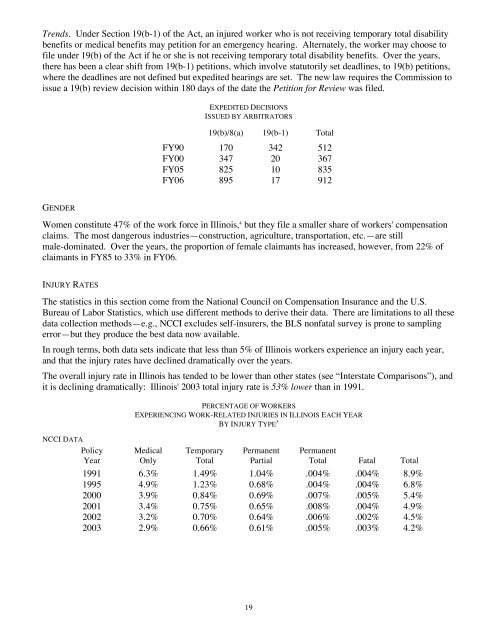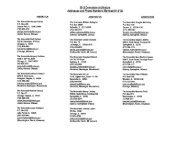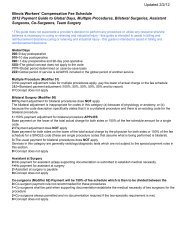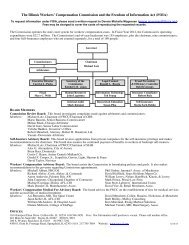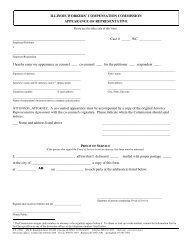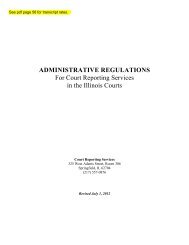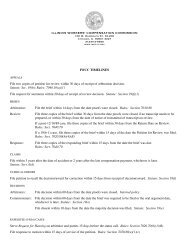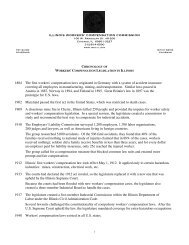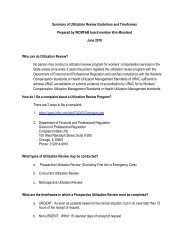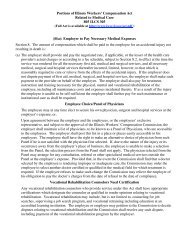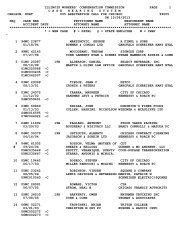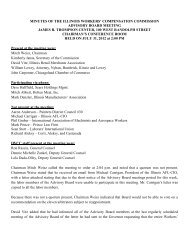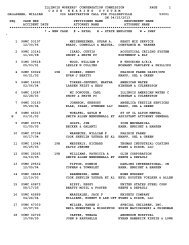illinois workers' compensation commission - IWCC - State of Illinois
illinois workers' compensation commission - IWCC - State of Illinois
illinois workers' compensation commission - IWCC - State of Illinois
Create successful ePaper yourself
Turn your PDF publications into a flip-book with our unique Google optimized e-Paper software.
Trends. Under Section 19(b-1) <strong>of</strong> the Act, an injured worker who is not receiving temporary total disability<br />
benefits or medical benefits may petition for an emergency hearing. Alternately, the worker may choose to<br />
file under 19(b) <strong>of</strong> the Act if he or she is not receiving temporary total disability benefits. Over the years,<br />
there has been a clear shift from 19(b-1) petitions, which involve statutorily set deadlines, to 19(b) petitions,<br />
where the deadlines are not defined but expedited hearings are set. The new law requires the Commission to<br />
issue a 19(b) review decision within 180 days <strong>of</strong> the date the Petition for Review was filed.<br />
EXPEDITED DECISIONS<br />
ISSUED BY ARBITRATORS<br />
19(b)/8(a) 19(b-1) Total<br />
FY90 170 342 512<br />
FY00 347 20 367<br />
FY05 825 10 835<br />
FY06 895 17 912<br />
GENDER<br />
Women constitute 47% <strong>of</strong> the work force in <strong>Illinois</strong>, 4 but they file a smaller share <strong>of</strong> <strong>workers'</strong> <strong>compensation</strong><br />
claims. The most dangerous industries—construction, agriculture, transportation, etc.—are still<br />
male-dominated. Over the years, the proportion <strong>of</strong> female claimants has increased, however, from 22% <strong>of</strong><br />
claimants in FY85 to 33% in FY06.<br />
INJURY RATES<br />
The statistics in this section come from the National Council on Compensation Insurance and the U.S.<br />
Bureau <strong>of</strong> Labor Statistics, which use different methods to derive their data. There are limitations to all these<br />
data collection methods—e.g., NCCI excludes self-insurers, the BLS nonfatal survey is prone to sampling<br />
error—but they produce the best data now available.<br />
In rough terms, both data sets indicate that less than 5% <strong>of</strong> <strong>Illinois</strong> workers experience an injury each year,<br />
and that the injury rates have declined dramatically over the years.<br />
The overall injury rate in <strong>Illinois</strong> has tended to be lower than other states (see “Interstate Comparisons”), and<br />
it is declining dramatically: <strong>Illinois</strong>' 2003 total injury rate is 53% lower than in 1991.<br />
PERCENTAGE OF WORKERS<br />
EXPERIENCING WORK-RELATED INJURIES IN ILLINOIS EACH YEAR<br />
BY INJURY TYPE 5<br />
NCCI DATA<br />
Policy Medical Temporary Permanent Permanent<br />
Year Only Total Partial Total Fatal Total<br />
1991 6.3% 1.49% 1.04% .004% .004% 8.9%<br />
1995 4.9% 1.23% 0.68% .004% .004% 6.8%<br />
2000 3.9% 0.84% 0.69% .007% .005% 5.4%<br />
2001 3.4% 0.75% 0.65% .008% .004% 4.9%<br />
2002 3.2% 0.70% 0.64% .006% .002% 4.5%<br />
2003 2.9% 0.66% 0.61% .005% .003% 4.2%<br />
19


